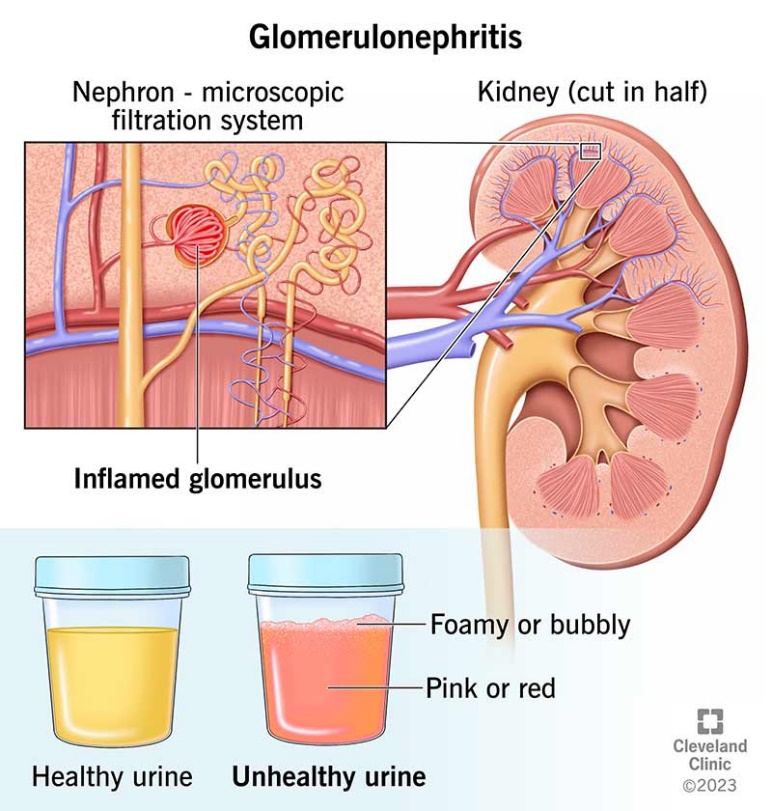A nurse is caring for a male client who has chronic glomerulonephritis. Which of the following findings should the nurse expect?
Urine specific gravity 1.035
Serum creatinine 7 mg/dL
Creatinine clearance 120 mL/min
BUN 15 mg/dL
The Correct Answer is B
Choice A reason:
Urine specific gravity is a measure of urine concentration. The normal range is typically from 1.005 to 1.030. A specific gravity of 1.035 indicates very concentrated urine, which could be due to dehydration or other factors, but it is not specifically indicative of chronic glomerulonephritis.
Choice B reason:
Serum creatinine is a waste product from the normal breakdown of muscle tissue. Normal levels are approximately 0.6 to 1.2 mg/dL for males. A level of 7 mg/dL is significantly elevated and can indicate severe kidney dysfunction, which is consistent with chronic glomerulonephritis. This condition can lead to a decreased ability of the kidneys to filter waste, causing an accumulation of creatinine in the blood.
Choice C reason:
Creatinine clearance is a test that measures how well creatinine is removed from the blood by the kidneys. The normal range is about 95 to 120 mL/min. A clearance of 120 mL/min is within the normal range and would not typically be expected in a client with chronic glomerulonephritis, as this condition usually results in reduced kidney function.
Choice D reason:
Blood urea nitrogen (BUN) is another waste product filtered by the kidneys. Normal BUN levels are between 7 and 20 mg/dL. A BUN of 15 mg/dL is within the normal range and does not necessarily indicate kidney dysfunction from chronic glomerulonephritis.

Nursing Test Bank
Naxlex Comprehensive Predictor Exams
Related Questions
Correct Answer is C
Explanation
Choice A reason:
While metabolic syndrome is associated with several health issues, it is not a direct risk factor for hyperthyroidism. Metabolic syndrome typically includes conditions like insulin resistance, hypertension, and dyslipidemia, which are more closely related to diabetes and cardiovascular diseases rather than thyroid function.
Choice B reason:
An iodine deficiency is commonly associated with hypothyroidism, not hyperthyroidism. Iodine is essential for the production of thyroid hormones, and a lack of it can lead to decreased hormone production and an underactive thyroid.
Choice C reason:
Graves' disease is the most common cause of hyperthyroidism. It is an autoimmune disorder where the immune system mistakenly attacks the thyroid gland, causing it to produce too much thyroid hormone. A 35-year-old male with Graves' disease would indeed be at high risk for hyperthyroidism.
Choice D reason:
While a family history of autoimmune disorders can increase the risk of developing autoimmune-related hyperthyroidism, it is not as direct a risk factor as having Graves' disease itself. Autoimmune disorders can have a genetic component, but having a family history does not guarantee the development of hyperthyroidism.
Correct Answer is B
Explanation
Choice A reason:
Purulent drainage at the intravenous site access site would indicate a more severe infection, possibly grade 3 or 4 on the Infusion Nurses Society's phlebitis scale. This would be associated with more advanced symptoms such as pus formation, which is not characteristic of grade 1 phlebitis.
Choice B reason:
Redness at the intravenous access site with pain is indicative of grade 1 phlebitis according to the Infusion Nurses Society's phlebitis scale. This grade is characterized by erythema and possible pain at the site of the IV insertion, without more severe symptoms such as swelling or streak formation.
Choice C reason:
Red streaks on the affected extremity suggest a progression of the inflammatory response, potentially indicating a higher grade of phlebitis, such as grade 2 or 3. This symptom suggests that the inflammation is spreading along the vein, which is more serious than grade 1 phlebitis.
Choice D reason:
A palpable venous cord in the affected extremity would also suggest a more severe form of phlebitis, likely grade 3. This occurs when a thrombus forms along with inflammation of the vein, leading to a palpable cord-like structure.
Whether you are a student looking to ace your exams or a practicing nurse seeking to enhance your expertise , our nursing education contents will empower you with the confidence and competence to make a difference in the lives of patients and become a respected leader in the healthcare field.
Visit Naxlex, invest in your future and unlock endless possibilities with our unparalleled nursing education contents today
Report Wrong Answer on the Current Question
Do you disagree with the answer? If yes, what is your expected answer? Explain.
Kindly be descriptive with the issue you are facing.
